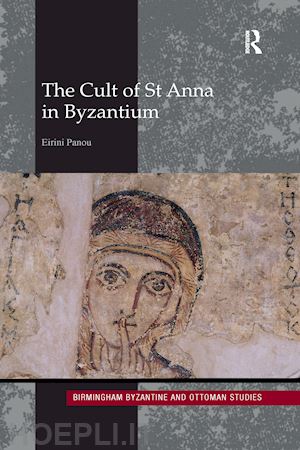Contents: List of illustrations; List of abbreviations; Introduction; Chapter 1: The emergence of St Anna's cult in Jerusalem and Constantinople, The Probatike and fifth-century ecclesiastical politics in Jerusalem, The church of Mary at the Probatike as Mary's birthplaceThe emerging cult of St Anna in Constantinople, The Justinianic model of the Probatike in the Post Sixth century topography of Constantinople: The Pege, the Chalkoprateia and the Hodegetria,Imperial patronage after Justinian I in Constantinople and beyond: Basil I- Leo VI, The text of Theophanes Continuator revisited, Justinian I, the Macedonian dynasty and St Anna, Conclusions; Chapter 2: Relics- Feasts- Social approaches, Part I. Relics, First group: Palestine-St Anna’s relics in the Probatike, Second group: From Palestine to France, Third group: The relics in Constantinople and Rome: The Patria and scholarly views, The translation according to the Patria, The translation from Constantinople to Rome: scholarly views and evidence, The relics in Constantinople in the sixteenth century, The Pammakaristos church, Fourth group: From Trebzond to Athos, Conclusions. Part II. Feasts, Introduction, The Conception of St Anna/ Kissing of Joachim and Anna, Significance of the feast, Scholarly views on the development of the feast Celebration in Constantinople, The Nativity of Mary, Significance of the feast, Origins in Palestine, Scholarly views on its development in Constantinople, Spread in Constantinople, The Entry of Mary, Development of the feast ,The Dormition of St Anna and the feast of Sts Anna and Joachim, Conclusions. Part III. Social approaches, Hagiography: St Anna and iconophilia, Hagiography :St Anna and childbirth, Histories: St Anna and iconophilia in Theophanes’s Chronographia and the Patria of Constantinople, Church calendars, hagiography and histories: Women at the church of Blachernai, Demonstration of Orthodoxy: Annas in monasteries- the Synodikon of Orthodoxy Nomenclaturem, Martyria of various Annas in Constantinople: The Russian travellers, St Anna the Virgin, Martyrs and Mothers named Anna, St Anna of Leukate, Conclusions to chapters 1 and 2; Chapter 3: The visual evidence, Egypt - Cathedral of Faras (eighth and tenth centuries), Constantinople and Rome in the fifth and sixth centuries, Santa Maria Antiqua: The Three Mothers, Chapel of St Nicholas, Paros (Greece, eighth century), Southern Italy- Crypt of St Christine (tenth century), Cappadocia (ninth to thirteenth centuries), The earliest extensive Mariological cycle. The Marian cycle in the chapel of Joachim and Anna at Kizil Tchoukour, Anna’s and Joachim’s iconic portraits, Anna as a mother, Glorification of Christ –Incarnational role, Healing qualities, Intercession-Deesis, Constantinople (tenth to fourteenth centuries), Ethiopia (thirteenth century), Greece (tenth to fifteenth centuries) , Central Greece Peloponnese, Greek islands (excluding Crete), Crete : Anna as a mother, Anna suckling the Virgin, Anna holding the Virgin, Christological associations: Anna and Joachim and the Mandylion, Christological associations: Anna and Joachim, the Mandylion and Mary’s Annunciation, Icons-Book covers, Fulfilment of prophecies, Military saints, Donors, Icons from Crete, Conclusions; Chapter 4: An overview; Bibliography; Index.











